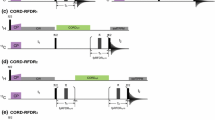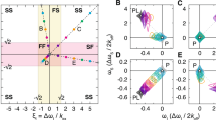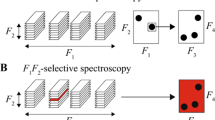Abstract
The access to weak alignment media has fuelled the development of methods for efficiently and accurately measuring residual dipolar couplings (RDCs) in NMR-spectroscopy. Among the wealth of approaches for determining one-bond scalar and RDC constants only J-modulated and J-evolved techniques retain maximum resolution in the presence of differential relaxation. In this article, a number of J-evolved experiments are examined with respect to the achievable minimum linewidth in the J-dimension, using the peptide PA4 and the 80-amino-acid-protein Saposin C as model systems. With the JE-N-BIRDd,X-HSQC experiment, the average full-width at half height could be reduced to approximately 5 Hz for the protein, which allows the additional resolution of otherwise unresolved peaks by the active (J+D)-coupling. Since RDCs generally can be scaled by the choice of alignment medium and alignment strength, the technique introduced here provides an effective resort in cases when chemical shift differences alone are insufficient for discriminating signals. In favorable cases even secondary structure elements can be distinguished.







Similar content being viewed by others
References
Bax A (2003) Weak alignment offers new NMR opportunities to study protein structure and dynamics. Protein Science 12:1–16
Bax A, Tjandra N (1997) High-resolution heteronuclear NMR of human ubiquitin in an aqueous liquid crystalline medium. J Biomol NMR 10:289–292
Bendiak B (2002) Sensitive through-space dipolar correlations between nuclei of small organic molecules by partial alignment in a deuterated liquid solvent. J Am Chem Soc 124:14862–14863
Bruschweiler R, Zhang FL (2004) Covariance nuclear magnetic resonance spectroscopy. J Chem Phys 120:5253–5260
Brutscher B, Boisbouvier J, Pardi A, Marion D, Simorre JP (1998) Improved sensitivity and resolution in H-1-C-13 NMR experiments of RNA. J Am Chem Soc 120:11845–11851
de Alba E, Weiler S, Tjandra N (2003) Solution structure of human Saposin C: pH-dependent interaction with phospholipid vesicles. Biochemistry 42:14729–14740
Delaglio F, Grzesiek S, Vuister GW, Zhu G, Pfeifer J, Bax A (1995) NMRpipe – a multidimensional spectral processing system based on unix pipes. J Biomol NMR 6:277–293
Fehér K, Berger S, Kövér KE (2003) Accurate determination of small one-bond heteronuclear residual dipolar couplings by F1 coupled HSQC modified with a G-BIRDr module. J Magn Reson 163:340–346
Freedberg DI (2002) An alternative method for pucker determination in carbohydrates from residual dipolar couplings: A solution NMR study of the fructofuranosyl ring of sucrose. J Am Chem Soc 124:2358–2362
Freeman R, Kupce E (2003) New methods for fast multidimensional NMR. J Biomol NMR 27:101–113
Freudenberger JC, Knör S, Kobzar K, Heckmann D, Paululat T, Kessler H, Luy B (2005) Stretched poly(vinyl acetate) gels as NMR alignment media for the measurement of residual dipolar couplings in polar organic solvents. Angew Chem Int Ed 44:423–426
Freudenberger JC, Spiteller P, Bauer R, Kessler H, Luy B (2004) Stretched poly(dimethylsiloxane) gels as NMR alignment media for apolar and weakly polar organic solvents: An ideal tool for measuring RDCs at low molecular concentrations. J Am Chem Soc 126:14690–14691
Goddard TD, Kneller DG San Francisco, University of California
Haberz P, Farjon J, Griesinger C (2005) A DMSO-compatible orienting medium: Towards the investigation of the stereochemistry of natural products. Angew Chem Int Ed 44:427–429
Hansen MR, Mueller L, Pardi A (1998) Tunable alignment of macromolecules by filamentous phage yields dipolar coupling interactions. Nat Struct Biol 5:1065–1074
John M, Wendeler M, Heller M, Sandhoff K, Kessler H (2006) Characterization of human saposins by NMR spectroscopy. Biochemistry 45:5206–5216
Jung YS, Sharma M, Zweckstetter M (2004) Simultaneous assignment and structure determination of protein backbones by using NMR dipolar couplings. Angew Chem Int Ed 43:3479–3481
Jung YS, Zweckstetter M (2004a) Backbone assignment of proteins with known structure using residual dipolar couplings. J Biomol NMR 30:25–35
Jung YS, Zweckstetter M (2004b) Mars – robust automatic backbone assignment of proteins. J Biomol NMR 30:11–23
Kessler H (1982) Peptide conformations 19 Conformation and biological activity of cyclic peptides. Angewandte Chemie-International Edition in English 21:512–523
Kim S, Szyperski T (2003) GFT NMR, a new approach to rapidly obtain precise high-dimensional NMR spectral information. J Am Chem Soc 125:1385–1393
Klages J, Neubauer C, Coles M, Kessler H, Luy B (2005) Structure refinement of Cyclosporin A in chloroform by using RDCs measured in a stretched PDMS-gel. ChemBioChem 6:1672–1678
Kneller DG, Kuntz ID (1993) J Cell Biochem Suppl 17 C:254
Kobzar K, Kessler H, Luy B (2005) Stretched gelatin gels as chiral alignment media for the discrimination of enantiomers by NMR spectroscopy. Angew Chem Int Ed 44:3145–3147
Koskela H, Kilpelainen I, Heikkinen S (2004) CAGEBIRD: improving the GBIRD filter with a CPMG sequence. J Magn Reson 170:121–126
Kövér KE, Batta G (2004) More line narrowing in TROSY by decoupling of long-range couplings: shift correlation and 1JNC' coupling constant measurements. J Magn Reson 170:184–190
Kövér KE, Forgó P (2004) J-modulated ADEQUATE (JM-ADEQUATE) experiment for accurate measurement of carbon-carbon coupling constants. J Magn Reson 166:47–52
Luy B, Barchi JJ, Marino JP (2001) S3E-E.COSY methods for the measurement of F-19 associated scalar and dipolar coupling constants. J Magn Reson 152:179–184
Luy B, Marino JP (2001a) Measurement and application of H-1-F-19 dipolar couplings in the structure determination of 2 '-fluorolabeled RNA. J Biomol NMR 20:39–47
Luy B, Marino JP (2001b) H-1-P-31 CPMG-correlated experiments for the assignment of nucleic acids. J Am Chem Soc 123:11306–11307
Luy B, Kobzar K, Kessler H (2004) An easy and scalable method for the partial alignment of organic molecules for measuring residual dipolar couplings. Angew Chem Int Ed 43:1092–1094
Luy B, Kobzar K, Knör S, Furrer J, Heckmann D, Kessler H (2005) Orientational properties of stretched polystyrene gels in organic solvents and the suppression of their residual H-1 NMR signals. J Am Chem Soc 127:6459–6465
Luy B, Marino JP (2003) JE-TROSY: combined J-and TROSY-spectroscopy for the measurement of one-bond couplings in macromolecules. J Magn Reson 163:92–98
Mandelshtam VA, Taylor HS, Shaka AJ (1998) Application of the filter diagonalization method to one-and two-dimensional NMR spectra. J Magn Reson 133:304–312
Martin-Pastor M, Bush CA (2001) Refined structure of a flexible heptasaccharide using H-1-C-13 and H-1-H-1 NMR residual dipolar couplings in concert with NOE and long range scalar coupling constants. J Biomol NMR 19:125–139
Meissner A, Duus JO, Sørensen OW (1997a) Integration of spin-state-selective excitation into 2D NMR correlation experiments with heteronuclear ZQ/2Q pi rotations for 1JXH-resolved E.COSY-type measurement of heteronuclear coupling constants in proteins. J Biomol NMR 10:89–94
Meissner A, Duus JO, Sørensen OW (1997b) Spin-state-selective excitation. Application for E.COSY-type measurement of JHH coupling constants. J Magn Reson 128:92–97
Mierke DF, Kurz M, Kessler H (1994) Peptide flexibility and calculations of an ensemble of molecules. J Am Chem Soc 116:1042–1049
Mori S, Abeygunawardana C, Johnson MO, Vanzijl PCM (1995) Improved sensitivity of HSQC spectra of exchanging protons at short interscan delays using a new fast HSQC (FHSQC) detection scheme that avoids water saturation. J Magn Reson B 108:94–98
Ottiger M, Delaglio F, Bax A (1998a) Measurement of J and dipolar couplings from simplified two-dimensional NMR spectra. J Magn Reson 131:373–378
Ottiger M, Delaglio F, Marquardt JL, Tjandra N, Bax A (1998b) Measurement of dipolar couplings for methylene and methyl sites in weakly oriented macromolecules and their use in structure determination. J Magn Reson 134:365–369
Permi P (2002) A spin-state-selective experiment for measuring heteronuclear one-bond and homonuclear two-bond couplings from an HSQC-type spectrum. J Biomol NMR 22:27–35
Pham TN, Liptaj T, Bromek K, Uhrín D (2002) Measurement of small one-bond proton-carbon residual dipolar coupling constants in partially oriented C-13 natural abundance oligosaccharide samples: Analysis of heteronuclear 1JCH-modulated spectra with the BIRD inversion pulse. J Magn Reson 157:200–209
Piotto M, Saudek V, Sklenar V (1992) Gradient-tailored excitation for single-quantum NMR-spectroscopy of aqueous solutions. J Biomol NMR 2:661–665
Prestegard JH (1998) New techniques in structural NMR – anisotropic interactions. Nat Struct Biol 5:517–522
Shaka AJ, Barker PB, Freeman R (1985) Computer-optimized decoupling scheme for wideband applications and low-level operation. J Magn Reson 64:547–552
Simon B, Sattler M (2002) De Novo structure determination from residual dipolar couplings by NMR spectroscopy. Angew Chem Int Ed 41:437–440
Sklenar V, Piotto M, Leppik R, Saudek V (1993) Gradient-tailored water suppression for H-1-N-15 HSQC experiments optimized to retain full sensitivity. J Magn Reson A 102:241–245
Thiele CM (2004) Simultaneous assignment of all diastereotopic protons in strychnine using RDCs: PELG as alignment medium for organic molecules. J Org Chem 69:7408–7413
Thiele CM (2005) Scaling the alignment of small organic molecules in substituted polyglutamates by variable-angle sample spinning. Angew Chem Int Ed 44:2787–2790
Thiele CM, Berger S (2003) Probing the diastereotopicity of methylene protons in strychnine using residual dipolar couplings. Org Lett 5:705–708
Tjandra N, Bax A (1997a) Direct measurement of distances and angles in biomolecules by NMR in a dilute liquid crystalline medium. Science 278:1111–1114
Tjandra N, Bax A (1997b) Measurement of dipolar contributions to 1JCH splittings from magnetic-field dependence of J modulation in two-dimensional NMR spectra. J Magn Reson 124:512–515
Tjandra N, Omichinski JG, Gronenborn AM, Clore GM, Bax A (1997) Use of dipolar H-1-N-15 and H-1-C-13 couplings in the structure determination of magnetically oriented macromolecules in solution. Nat Struct Biol 4:732–738
Tolman JR, Prestegard JH (1996a) Measurement of amide N-15-H-1 one-bond couplings in proteins using accordion heteronuclear-shift-correlation experiments. J Magn Reson B 112:269–274
Tolman JR, Prestegard JH (1996b) A quantitative J-correlation experiment for the accurate measurement of one-bond amide N-15-H-1 couplings in proteins. J Magn Reson B 112:245–252
Uhrín D, Liptaj T, Kövér KE (1993) Modified BIRD pulses and design of heteronuclear pulse sequences. J Magn Reson A 101:41–46
Verdier L, Sakhaii P, Zweckstetter M, Griesinger C (2003) Measurement of long range H,C couplings in natural products in orienting media: a tool for structure elucidation of natural products. J Magn Reson 163:353–359
Wendeler M, Hoernschemeyer J, John M, Werth N, Schoeniger M, Lemm T, Hartmann R, Kessler H, Sandhoff K (2004) Expression of the GM2-activator protein in the methylotrophic yeast Pichia pastoris, purification, isotopic labeling, and biophysical characterization. Protein Expression and Purification 34:147–157
Yan JL, Delaglio F, Kaerner A, Kline AD, Mo HP, Shapiro MJ, Smitka TA, Stephenson GA, Zartler ER (2004) Complete relative stereochemistry of multiple stereocenters using only residual dipolar couplings. J Am Chem Soc 126:5008–5017
Yan JL, Kline AD, Mo HP, Shapiro MJ, Zartler ER (2003) A novel method for the determination of stereochemistry in six-membered chairlike rings using residual dipolar couplings. J Org Chem 68:1786–1795
Yang DW, Tolman JR, Goto NK, Kay LE (1998) An HNCO-based pulse scheme for the measurement of C-13(alpha)-H-1(alpha) one-bond dipolar couplings in N-15, C-13 labeled proteins. J Biomol NMR 12:325–332
Acknowledgment
B.L. and H.K. thank the Fonds der Chemischen Industrie and the Deutsche Forschungsgemeinschaft (Emmy Noether fellowship LU 835/1-1; Ke 147/37-1) for financial support. We thank Martin Sukopp (Stanford University, USA) for the synthesis of PA4, Michaela Wendeler (National Cancer Institute, Frederick MD, USA) and Konrad Sandhoff (Universität Bonn, Germany) for kindly providing Saposin C and Jochen Klages (TU München, Germany) for help with the assignment of Saposin C.
Author information
Authors and Affiliations
Corresponding author
Appendix
Appendix
Neglecting strong coupling artifacts, the evolution of transverse operators during a BIRDd,X element applied to a three spin system consisting of one heteronucleus X, one directly coupled proton spin I d, and one remotely coupled proton spin I r with the corresponding couplings J d,X > J d,r ≈ J r,X , results in the following transfers:
If we assume that long-range heteronuclear and homonuclear couplings can be neglected during the BIRDd,X element, the transfers can be simplified to
for proton transverse operators and
for the corresponding transverse operators of the heteronucleus. The magnetization of every other operator is scaled by \({\cos(2\pi\delta^{1}J_{d,X})},\) resulting in an average loss of \({0.5^\ast(1- \cos(2\pi\delta^{1}J_{d,X}))}\) due to incomplete transfer during the BIRDd,X filter.
To examine the influence of homonuclear and long-range heteronuclear couplings, we assume a perfectly matched delay δ, leading to \({\hbox{cos}(2\pi\delta^{1}J_{d,X})=-1}\) and \({\sin(2\pi\delta^{1}J_{d,X})=0}.\) The transfers are then
and
As with the direct one-bond coupling, every other transverse component is scaled by the homonuclear coupling \({\cos(2\pi \delta ^{1}J_{d,r})},\) causing an average loss of magnetization of 0.5*(1- \({\cos(2\pi \delta ^{1}J_{d,r}))}.\) Heteronuclear long-range couplings, instead, do not affect proton transverse operators, but reduce all transverse operators on the heteronucleus according to \({(1-\cos(2\pi \delta ^{1}J_{r,X}))}.\)
Rights and permissions
About this article
Cite this article
Furrer, J., John, M., Kessler, H. et al. J-Spectroscopy in the presence of residual dipolar couplings: determination of one-bond coupling constants and scalable resolution. J Biomol NMR 37, 231–243 (2007). https://doi.org/10.1007/s10858-006-9130-x
Received:
Accepted:
Published:
Issue Date:
DOI: https://doi.org/10.1007/s10858-006-9130-x




